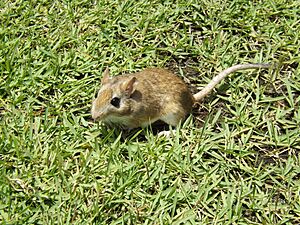Tristram's jird facts for kids
Quick facts for kids Tristram's jird |
|
|---|---|
 |
|
| Conservation status | |
| Scientific classification | |
| Genus: |
Meriones
|
| Species: |
tristrami
|
| Synonyms | |
|
|
The Tristram's jird (also known as Meriones tristrami) is a small rodent that lives in the Middle East. It was named after Henry Baker Tristram, who first found these animals. This jird can grow up to 155 mm long.
It makes its home in burrows in dry, grassy areas called steppes and semi-deserts. You can find them from Turkey and the Caucasus mountains all the way to Israel and Iran. Some have even been seen on the Greek island of Kos. This is the only place in Europe (outside the former Soviet Union) where gerbils have been reported. Tristram's jird is a common animal and is not considered to be in danger.
Contents
What Does Tristram's Jird Look Like?
The Tristram's jird is a small rodent. Its body, not counting its tail, is usually between 100 and 155 mm long. Its head, or skull, is about 32 to 40 mm long.
Its fur is a dark yellowish-brown color on its back. The fur on its sides is a yellowish-orange. Its belly is white. The bottom of its back feet do not have hair on the heels. The tail has two colors and has a small black tuft at the end. This tuft is about one-quarter the length of the tail.
Where Do Tristram's Jirds Live?
You can find the Tristram's jird in many countries. They live in Turkey, and in the Caucasus region, which includes Armenia and Azerbaijan. They also live south through Iraq, Syria, Lebanon, and Israel, reaching Jordan and Iran.
They were once seen on the Greek island of Kos. However, they haven't been spotted there for over ten years. These sightings on Kos are special. They are the only times a gerbil has been reported in a European country. This excludes countries that were part of the former Soviet Union. It's also the only gerbil found on an island in the eastern Mediterranean Sea. Old fossils show that this jird has lived in the southern Levant area for at least 160,000 years.
Tristram's Jird Habitat and Food
Tristram's jirds live in semi-deserts and steppes. These are dry, open areas with lots of grass. They seem to need places that get at least 100 mm of rain each year.
They eat different kinds of seeds and leaves. Even though they live in burrows underground, they do not store food there.
How Scientists Study Tristram's Jird
The Tristram's jird was first described by a scientist named Oldfield Thomas in 1892. He used samples collected by "Canon H. B. Tristram" from the Dead Sea area in Israel. The jird's scientific name, tristrami, honors Henry Baker Tristram.
This jird belongs to a group of gerbils called Meriones. Sometimes, scientists have thought that Tristram's jird was part of another species called Meriones shawi. Many different types of Tristram's jird have been described. However, the differences between them are very small. Because of this, most scientists do not recognize separate types of Tristram's jird anymore.
Protecting Tristram's Jird
The Tristram's jird lives in a very large area. Many of these areas are protected areas, which helps keep them safe. There are no major threats to this animal. Because it is common and widespread, it is listed as being of Least Concern on the IUCN Red List. This means it is not currently in danger of disappearing.


